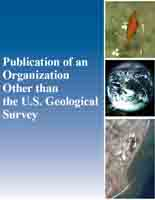Fomites could determine severity of SARS-CoV-2 outbreaks in low-density white-tailed deer (Odocoileus virginianus) populations
Links
- More information: Publisher Index Page (via DOI)
- Data Release: USGS data release - Code for Fomites could determine severity of SARS-CoV-2 outbreaks in low-density white-tailed deer Odocoileus virginianus populations
- Open Access Version: Publisher Index Page
- Download citation as: RIS | Dublin Core
Abstract
The establishment of a reservoir species for zoonotic diseases is concerning for both animal and human health. Severe acute respiratory syndrome coronavirus (SARS-CoV)-2, the coronavirus responsible for the COVID-19 pandemic, has been detected in white-tailed deer (Odocoileus virginianus) in the United States. Since its initial detection, various studies have documented circulation and evolution of SARS-CoV-2 in deer, with human cases suspected of spill-back from infectious deer. A priority for mitigating SARS-CoV-2 outbreaks in deer populations is determining the contribution of direct (via aerosols and physical contact) and indirect (via contaminated objects and media) transmission pathways. We expanded existing epidemiological models founded on direct transmission pathways to include three indirect transmission pathways of infection for simulated deer populations, including contaminated water, food waste, and feed piles. Despite lower infection probabilities and transmission hazards (measured by force-of-infection (FOI)) posed solely by these indirect pathways compared to direct transmission pathways, the addition of indirect transmission pathways increased FOI, which had ramifications for the severity of SARS-CoV-2 outbreaks in simulated deer populations, particularly in populations with low degrees of spread between deer (measured by basic reproductive number; R0). We used contact rate models to estimate SARS-CoV-2 spread across deer range in the United States and identified widespread potential for indirect transmission to increase the severity of outbreaks in low-density deer populations. These results indicate that indirect transmission pathways need to be considered in the management of white-tailed deer as a reservoir species for SARS-CoV-2.
| Publication type | Article |
|---|---|
| Publication Subtype | Journal Article |
| Title | Fomites could determine severity of SARS-CoV-2 outbreaks in low-density white-tailed deer (Odocoileus virginianus) populations |
| Series title | Transboundary and Emerging Diseases |
| DOI | 10.1155/tbed/1352911 |
| Volume | 2025 |
| Publication Date | June 04, 2025 |
| Year Published | 2025 |
| Language | English |
| Publisher | Wiley |
| Contributing office(s) | Coop Res Unit Leetown, Eastern Ecological Science Center |
| Description | 352911, 13 p. |


